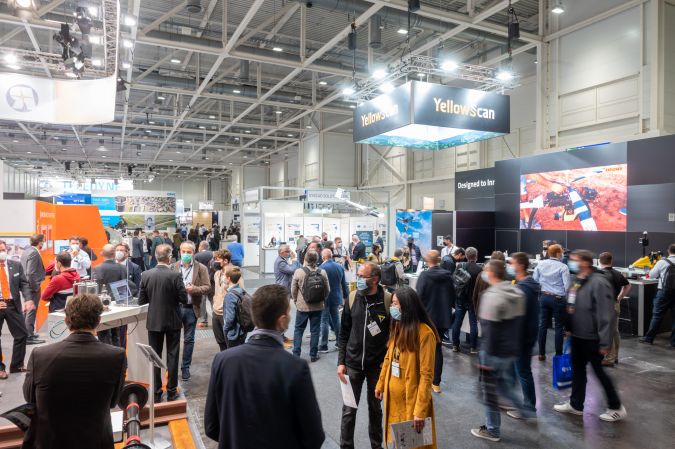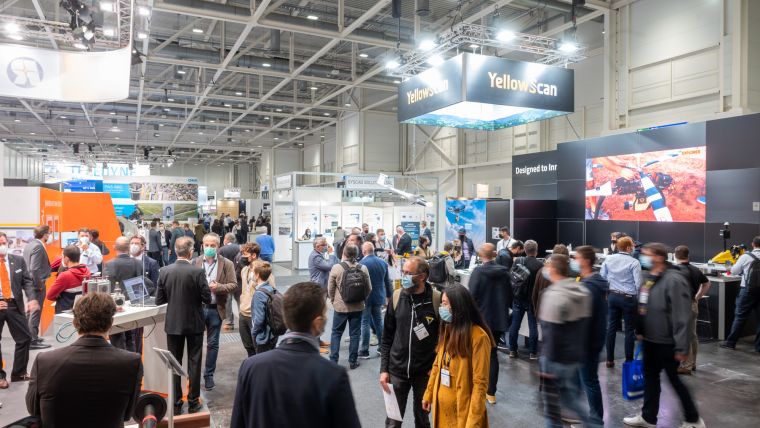5 Questions about Intergeo 2021
Reflections on the World’s Leading Geospatial Event
GIM International asked organizers Christoph Hinte from Hinte Messe and Christiane Salbach from DVW to look back on the most recent Intergeo and also to share a glimpse of next year’s event. Intergeo 2021 was held in a hybrid format from 21-23 September, facilitating valuable knowledge exchange between members of the geospatial community in multiple ways – both in the carefully laid-out, coronavirus-proof halls at the spacious exhibition centre in the German city of Hannover, and online via the digital platform.
How do you feel when you reflect on the hybrid edition of Intergeo?
Christiane Salbach (CS): I am grateful that we were able to hold Intergeo both with a high physical attendance in Hanover and also in parallel on the digital platform. It was a long road between hopes and fears in the run-up. It was always clear that Intergeo would definitely take place, but in the worst-case scenario it would only have been possible as a purely digital event. So in that respect, it was a big relief to finally be able to meet up in person again.
Christoph Hinte (CH): People widely expressed their appreciation that, even in the difficult times of the pandemic, Intergeo provided the best possible solution on the scheduled dates, with a digital offering last year and a hybrid concept this year. Intergeo 2021 attracted 5,000 live visitors and 4,000 online participants, and our survey revealed that over 80% of exhibitors were satisfied with the event. As a member of the organizing team, I am naturally very pleased with this in these confusing times.
After 18 months of COVID-19 restrictions, it was finally possible to hold this year’s Intergeo as a physical event. What was the atmosphere like, and what kind of feedback did you receive from attendees?
CS: There was that real trade fair and conference feeling again. For me personally, it was the first event where I met and talked to so many people. And all participants – exhibitors and visitors alike – were genuinely pleased that personal, face-to-face discussions were possible again. Conferencing tools can be useful to exchange information, but they are no substitute for encounters in real life. This was uniquely possible for the geospatial community at Intergeo in 2021.
CH: You could clearly sense that members of the geospatial community were happy to get together again in person at Intergeo in Hannover after a gap of two years. There was a positive atmosphere and the feedback was gratifyingly good from all sides, both in the personal conversations and also in the results of the visitor survey. Of course, with 250 exhibitors it was a significantly smaller event than in Stuttgart in 2019, but that was the maximum we could allow under the given circumstances. We were very lucky to find a super-competent and flexible team at Deutsche Messe AG in Hannover, who were instrumental in the success of Intergeo. We couldn’t hold the traditional Intergeo party on the Wednesday evening, of course, but we will definitely make up for that next year in Essen!

What was the common thread running through the conference programme, and what were the highlights?
CS: One common thread running through the conference was the digitization of our environment. There were numerous applications and innovations on display that are developing rapidly as a result of increasing digitization, and that become ‘smart’ when they are linked to additional information from other disciplines. As Hansjörg Kutterer, president of the DVW and organizer of Intergeo, rightly said: “Our world is becoming smarter and we are accompanying and shaping the process”. Some very good illustrative examples can be found in the area of smart cities, for instance. Digital citizen participation can provide important impetus here, but also in planning processes. Digital processes will accelerate developments in real estate valuation, too. Transparency and data-driven observation of effects and strategies for the provision of building land can be derived from this. The sessions dealing with data acquisition and the provision or application of municipal and official geodata, such as urban data platforms, were also very popular. Another highlight was the top-class panel discussion on building information modelling, which illuminated the different roles and their understanding in the BIM process. In general, the digital twin was a dominant topic, as it is not only omnipresent in the areas already mentioned, but also in smart construction, sensors/robotics and autonomous driving.
CH: Another common thread was the internationalization of the programme. This is welcomed by more than half of the conference participants, so the DVW programme committee is taking care to meet this request. Additionally, to highlight the interdisciplinary approach, for example with cartographers or other neighbouring fields, the programme aimed to anticipate future topics and developments and thus contribute to the innovation process.
Intergeo is traditionally the event where companies reveal their new products. Based on the new product launches and equipment showcased this year, what are the most striking developments in the geospatial industry?
CH: Around two thirds of the products exhibited were new or updated developments, so there is great dynamism and innovative power in the industry. It’s not just the product innovations that represent the developments, but above all the application examples and projects in the various fields that are addressed by the community at Intergeo and then transferred to everyday work.

What are your expectations for next year’s Intergeo?
CS: We expect to be almost back to normal operations next year at Intergeo in Essen. This year, there were still significant travel restrictions and, in some cases, personal reluctance to physically attend events. However, the exhibitors and visitors who were present indicated to us that they enjoyed this year’s Intergeo very much and that the date in Essen is already firmly in their diary.
CH: More than 80% of the exhibitors have already indicated that they will be in Essen next year. In addition, there is a high quota of returnees who had to miss this year due to the pandemic. The floorplans are already filling up due to re-bookings. The event in Essen traditionally attracts a high number of visitors from western Germany, and the Benelux countries are always particularly well represented. Thanks to the airports in Düsseldorf and Cologne, there are also good travel links for international guests from further afield. In terms of content, the topics of BIM and digital construction will continue to gain in importance. Many infrastructure projects are underway, which is having a noticeable effect on demand.
Intergeo 2022 will be held from 18-20 October in Essen.


Value staying current with geomatics?
Stay on the map with our expertly curated newsletters.
We provide educational insights, industry updates, and inspiring stories to help you learn, grow, and reach your full potential in your field. Don't miss out - subscribe today and ensure you're always informed, educated, and inspired.
Choose your newsletter(s)
























